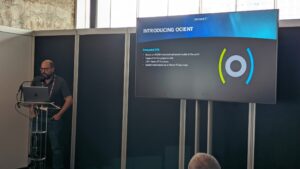 By Neil Kumar, Senior Product Manager at Ocient
By Neil Kumar, Senior Product Manager at Ocient
If you’re a geospatial data geek (like we all are at Ocient), two recent conferences, the Geospatial World Forum 2023 in Rotterdam, Netherlands and GEOINT 2023 in St. Louis offered an important glimpse at the latest news and innovations happening in a fast-moving industry. Our teams attended both events and we wanted to share insights into 3 key takeaways from the thought-provoking presentations and industry-leaders who took to the stages, including some of our own colleagues at Ocient.
#1 A Focus on In-Database Machine Learning for Faster Geospatial Forensics
The theme of the Geospatial World Forum was “Geospatial Caravan Embracing One and All” and our team was invited to join the caravan after being accepted to share what we’ve been working on with the latest release of V22 of the Ocient Hyperscale Data Warehouse. Co-Founder and Distinguished Engineer, Jason Arnold, and our VP of Product Management, Dylan Murphy, each shared a glimpse at new features in the Ocient Hyperscale Data Warehouse that leverage in-database machine learning for geospatial forensics and threat protection.
For example, imagine you’re a government agency in a major city tasked with monitoring and securing a landmark. You want to track and predict flying objects that might pose a threat to enter the airspace near that landmark. In the Ocient presentation, using our Ocient Hyperscale Data Warehouse and SQL, we demonstrated how you can build a machine learning model using previous air flight paths and tables of time around any given airspace to define and anticipate the biggest risks. It’s work that just a few years ago would not have been possible at this scale within a data warehouse. You can see a more complete demo below.
Along similar lines, there is no doubt that Machine Learning (ML) for labelling and classification and AI for ease of use are hot topics. We heard how a significant amount of time is spent on data exploration and preparation, raising the question of how SQL could be leveraged to streamline processes and enhance data scientists’ efficiency. Can a data warehouse with robust ELT support and an integrated ETL platform streamline this process? You bet, and it’s what we’ve been working on at Ocient.
#2 The Need to Democratize and Consolidate Complex Geospatial Data
A theme we heard at both conferences was the “Democratization and Consolidation” of spatial data. The ubiquity of GNSS trackers in mobile devices has led to a deluge of spatial data that has quickly become business critical across industries like government agencies, telecommunications, AdTech and more. The core challenge lies not just in managing the data, but in ingesting it continuously at scale from multiple sources into a single, reliable platform. It was also an opportunity to learn more about how companies like TomTom and Meta are making strides in data consolidation with their open data format initiative, the Overture Foundation. The Foundation aligns closely with a key theme in our product roadmap for 2023 which is all about enabling customers to consolidate their data analytics tools. We continue to hear how the current sprawl of data analytics tools across enterprises do not scale. Instead of unlocking innovation, we have learned that teams can lose development cycles on maintenance. With a few new recent customers, we’ve helped simplify their data stacks in ways that make analyzing more cost-efficient and easier to maintain. Too often we’re hearing that data technology has become too complex and does not scale for the complexities and realities of geospatial data at scale and it’s what we’ve been working on at Ocient.
An illuminating example of this need came from several government agencies from across the world that are striving to ensure comprehensive network coverage in rural areas for all citizens to access emergency services. This involves combining data on population distribution, existing infrastructure, and more – a task made complex by the disparate nature of these data sources that must be continuously loaded and analyzed in interactive time with no margin for error.

#3 Customers Looking to Unleash New Use Cases that Unlock Previously Not Possible Capabilities
A use case for Ocient which we discussed at both conferences was analyzing Call Detail Records (CDRs). Discussions at the forum emphasized that while CDR data is widely used, its full potential is yet to be tapped. The ability to integrate and analyze CDR data alongside other business information in a high-performance, real-time platform like Ocient presents a powerful opportunity for telecommunications providers and government regulatory authorities.
Lastly the topic of LiDAR Surveying was particularly fascinating, with applications ranging from forestry management to disaster recovery looking to analyze massive datasets. The data essentially comprises an ST_Point column for the spatial data and an altitude column – a format that fits perfectly with Ocient’s capabilities, which include supporting complex columns alongside spatial data. Importantly, this opens the door for in-database machine learning on this data, given its simple columnar structure.
In conclusion, the industry is moving quickly and conversation at both GEOINT and the Geospatial World Forum 2023 provided a valuable source of insights and networking opportunities across the latest innovations and challenges within a variety of industries leveraging geospatial intelligence and analytics. The learnings from the conference validated a lot our roadmap and we remain excited about our future releases focused on analyzing spatial data. If you’d like to learn more or see a live geospatial demo of Ocient, get in touch today.

